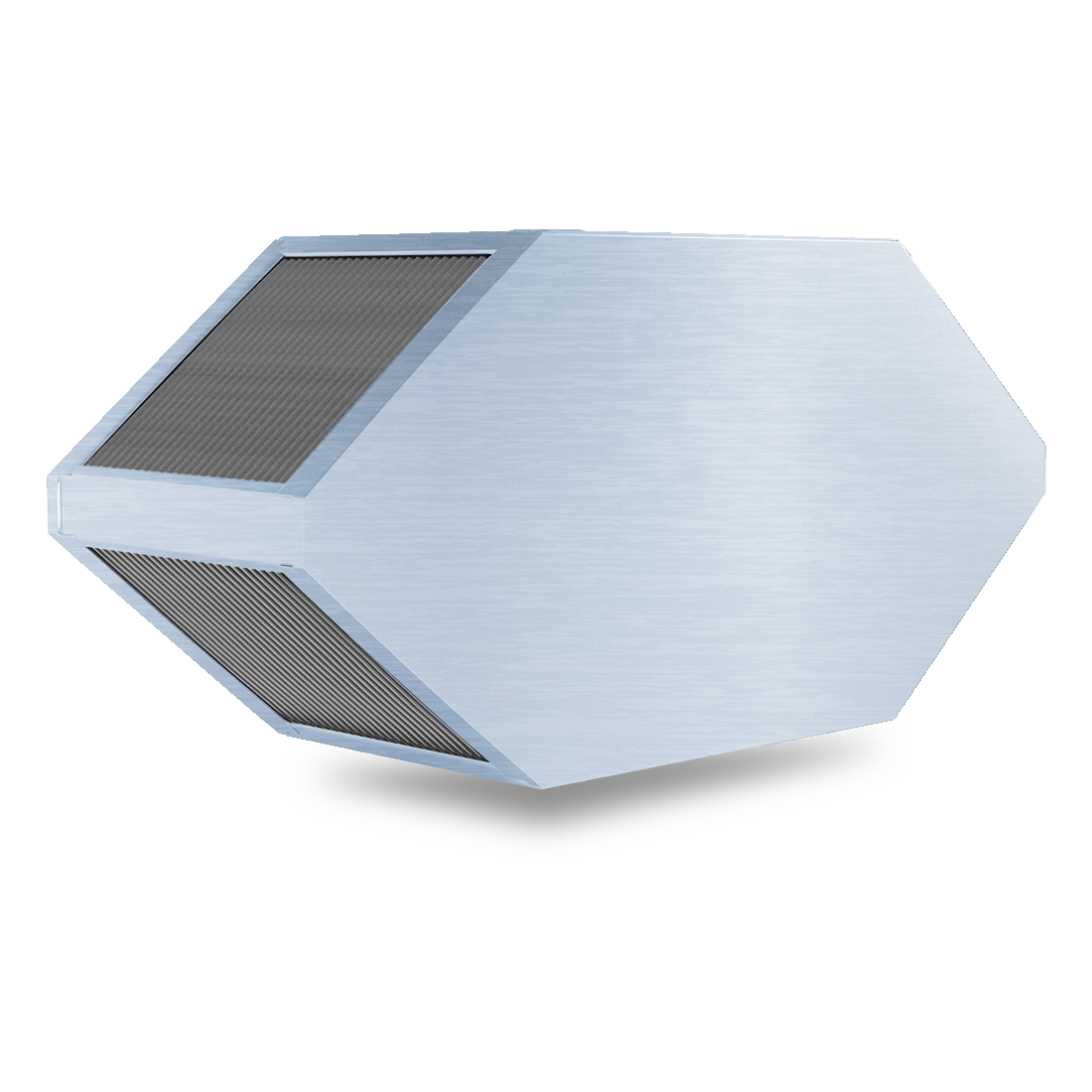


ALUMINIUM COUNTER-FLOW HEAT EXCHANGER
ALUMINIUM COUNTER-FLOW HEAT EXCHANGER
Aluminum counter-flow plate heat exchangers with high efficiency of up to 93% are the ideal solution for small to medium air volume recovery in residential or commercial applications.




- CASING AND PLATES MATERIAL — CORROSION-RESISTANT ALUMINUM
- NO ODOR AND MOISTURE TRANSMISSION
- HIGH EFFICIENCY WITH SMALL DIMENSIONS
- NON-FLAMMABLE
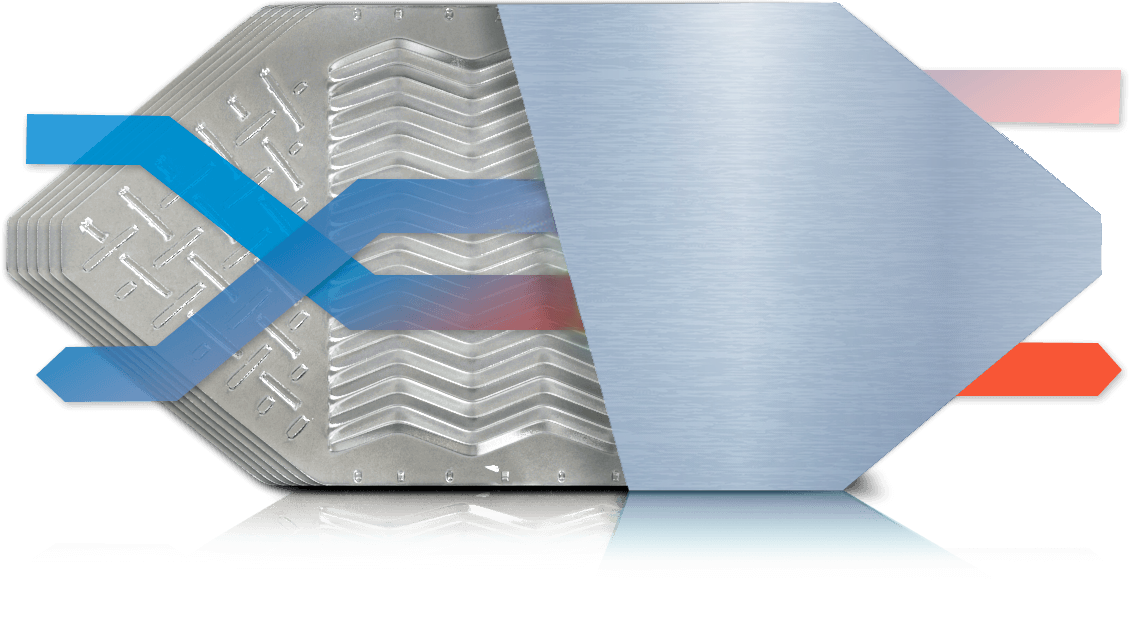
Maximum efficiency
93
Our devices are focused on energy recovery and allow the end-user to save up to 93% of energy resources. All this is carried out in accordance with ECO DESIGN 2016 and EU legislation aimed at reducing energy consumption in buildings. You can use our equipment in residential, commercial, or public ventilation and air conditioning systems.
To learn how a counter-flow heat exchanger works, we incvite you to watch a short video.
HOW AN AIR-TO-AIR HEAT EXCHANGER WORKS
Inside the heat exchanger, fresh and exhaust air streams flow through parallel channels in the counter-flow directions. Heat is transferred when the streams cross each other. The channels through which the air passes are completely separated.
COUNTER-FLOW HEAT EXCHANGER’S MAIN CHARACTERISTICS
- Complete separation of fresh and exhaust airflows
- Heat recovery efficiency up to 93%
- High sensible heat recovery
- Maximum sealing of joints between plates
- Sealed housing without screws or rivets

BY-PASS AND DAMPERS

- The heat exchanger consists of a large number of metal plates separating the supply and exhaust airflows. The warm flow of exhaust air flowing through the walls of the heat exchanger heats the supply air. The streams do not mix with each other.
- The main disadvantage of a metal heat exchanger is condensate, which at low temperatures can cause freezing. To avoid this, it is recommended to use a by-pass system: cold supply air passes through the bypass compartment, and the outgoing heat defrosts the heat exchanger. The by-pass system can be installed in any part of the heat exchanger.
- The use of dampers and by-pass may affect the energy consumption of the fan, but on the other hand, the system will have higher seasonal efficiency.
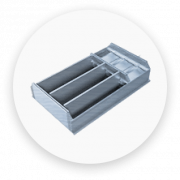 HEIGHT OF DAMPER FLAP PROFILES
HEIGHT OF DAMPER FLAP PROFILES| MODEL | HEIGHT, MM | GEAR TYPE |
|---|---|---|
| 50 A | 50 mm | Hidden gears |
| 100 A | 100 mm | Hidden gears |
 USAGE CLASS AND APPLICATION AREA
USAGE CLASS AND APPLICATION AREA| CLASS | APPLICATION AREA |
|---|---|
| C(2) | Residential Institutions |
| C(3) | Dwellings, Houses, Flats, Apartments |
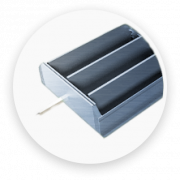 ACTUATOR
ACTUATOR| AH ALUMINUM HANDLE |
|---|
| PA preparation for electric actuator (side mounted) |
| PT preparation for electric actuator (top mounted) |
DIMENSIONS OF COUNTER-FLOW HEAT EXCHANGERS


- The following table shows all available models and dimensions of aluminum plate counter-flow heat exchangers.
- The sides A, B, D, E, F, and G are fixed. The dimension C is the width of the exchanger and can be set manually.
- The width of all available exchanger models can be manufactured from 100 mm to 1000 mm in a one-piece unit.
- The heat exchanger with a width of 1000 mm or more is supplied in two or more blocks.
- Each heat exchanger model can be equipped with a bypass (on request). The parameters are automatically calculated by the selection program.
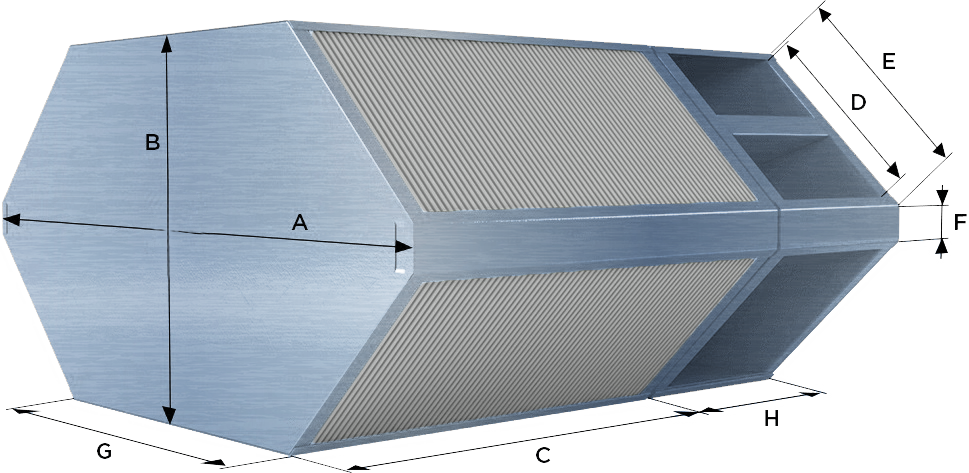
COUNTER-FLOW HEAT EXCHANGER SIZES
According to VDI 6022, the cleaning of the components must be carried out including the core.
- The aluminum heat exchanger can be cleaned with a high-pressure washer up to 5 bar.
- Cleaning can be done with cold or warm water up to 70°C.
- Use of household cleaners is allowed.
- The plates and casing of the heat exchanger are resistant to corrosion.
Proper and timely maintenance of the heat exchanger must comply with the VDI 6022 standard, which clearly states that air conditioning devices must provide safe and comfortable indoor climate conditions.
The VDI also states that the health risks and potential deterioration of well-being through air contaminated with microorganisms and bacteria should be avoided.
- The counterflow heat exchangers are made of high-quality aluminum.
- The materials are identical to those used in conditions of possible corrosion or in constant contact with seawater.
- Conform to the requirements of VDI 6022.
- Tested for inertness, microbial safety, and hygiene of aluminum foil (alloy 8079) and aluminum sheets - grade: EN AW-5754 (AlMg3).

THE AIR HEAT EXCHANGER CAN HAVE DIFFERENT TYPES OF COATING

- Aluminum coating. The maximum pure aluminum alloy is used, with a minimum content of iron and copper, mainly affecting the corrosion resistance. We use aluminum alloy number 8079, characteristic "0".
- Epoxy coating. Used in environments where there is a high likelihood of corrosion or stringent exploitation requirements. Complete protection against aggressive environments by isolating the end portions of the plates. First-class solution for use near pools, indoors near the coast, and in spray booths.
- Hydrophilic coating changes the surface properties of the heat exchanger and significantly reduces the drop angle. The benefit is quick dehumidification of the heat exchanger, reduction of total resistance, and avoidance of freezing by 20%. Used for adiabatic air conditioning systems.
- Antibacterial coating. Antibacterial treatment of metal creates an unfavorable environment for the reproduction of microbes, viruses, and fungi. Mainly used for medical premises.
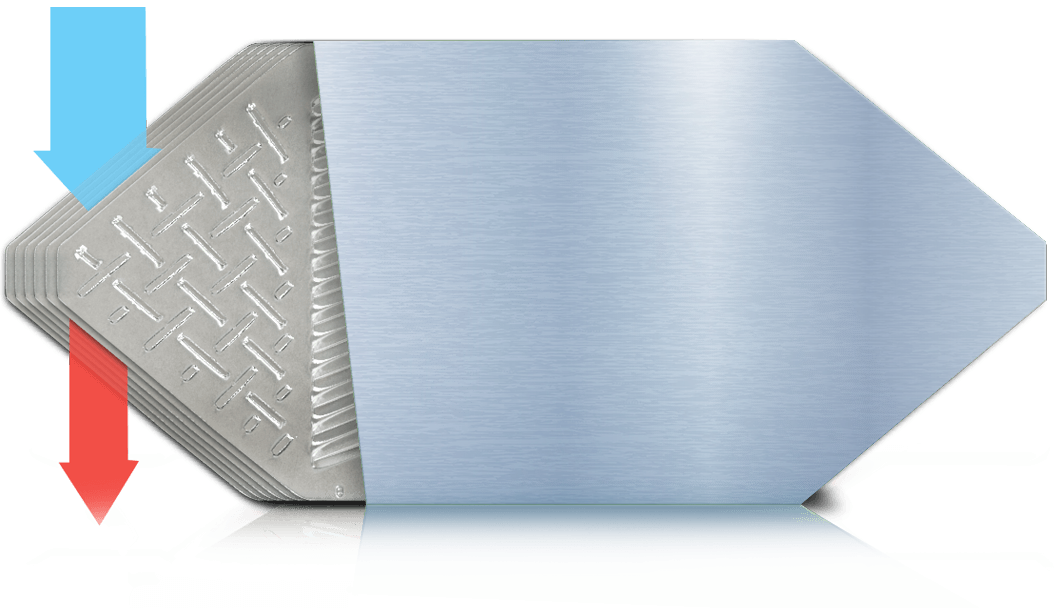
- Air leakage (or infiltration) is outside air that enters the house uncontrollably through cracks, doors, and windows.
- During winter or windy weather, too much air can enter the house, and during summer or calm weather, too little. In addition, in a “leaky” house, dust and mold appear over time.
- Unintentional or accidental entry of outdoor air into a building is accompanied by exfiltration elsewhere in the building. In winter, this can cause warm, humid indoor air to move into the colder part of the room, causing condensation and mold to form.
- Air leakage control is important but often overlooked when building an energy-efficient home. Increasing the tightness of the system due to sealing and additional sizing has a positive effect.
DECLARATION
We declare that all counter-flow heat exchangers with the assigned PCF Code are produced and tested in order to grant leakage below 0,25%.
TEST PROCEDURE
Before sending products to customers, we test each of the recuperators produced for tightness. The test is carried out with high-precision instruments at a pressure of 100/250/400 Pa. The test result can be sent along with the products upon request.
AN ENERGY-EFFICIENT HOUSE WILL HAVE:
- Lower heating bills due to less heat loss
- Fewer drafts
- Less opportunity for mold to grow
- More efficient ventilation system
- Less need for heating and cooling
Our goal is to provide ventilation-controlled unit producers with heat exchangers with the least leakage and air mixing. We state that the percentage of leakage and mixing of air in our recuperators reaches 0.25%, while the Eurovent Norm sets a maximum value of 0.5%.

Each batch of recuperators passes through a laboratory to check for tightness and compliance with Eurovent standards.

The inner part of the heat exchanger (plates connection) and the outer part (casing) are tested on special laboratory equipment at pressures up to 400 Pa.

Each heat exchanger with an air leakage result of 0.25% receives a test certificate and is sent to the finished product warehouse.

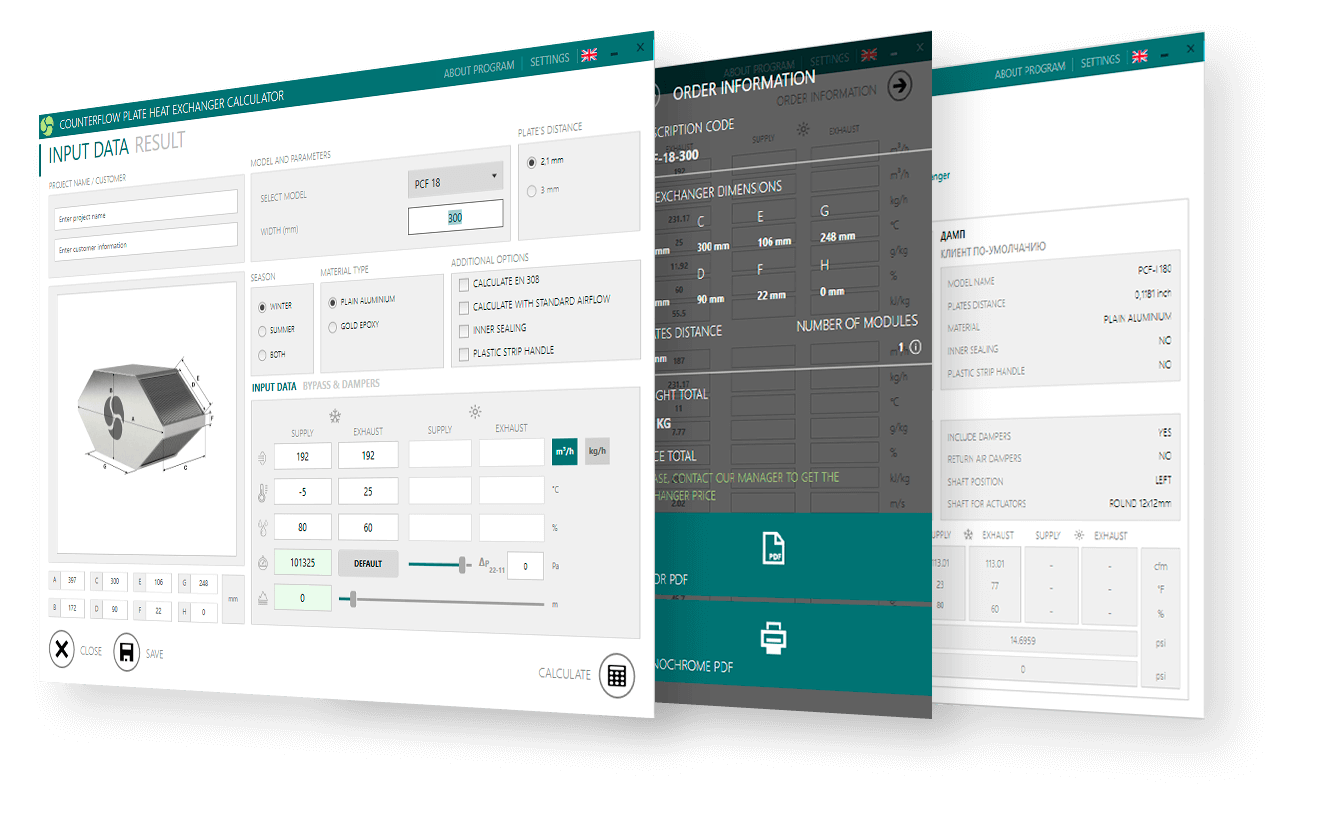
The selection program calculates the technical characteristics of the counterflow plate heat exchanger. Available both in a standalone version and in dll format for integration into client software.
Download the software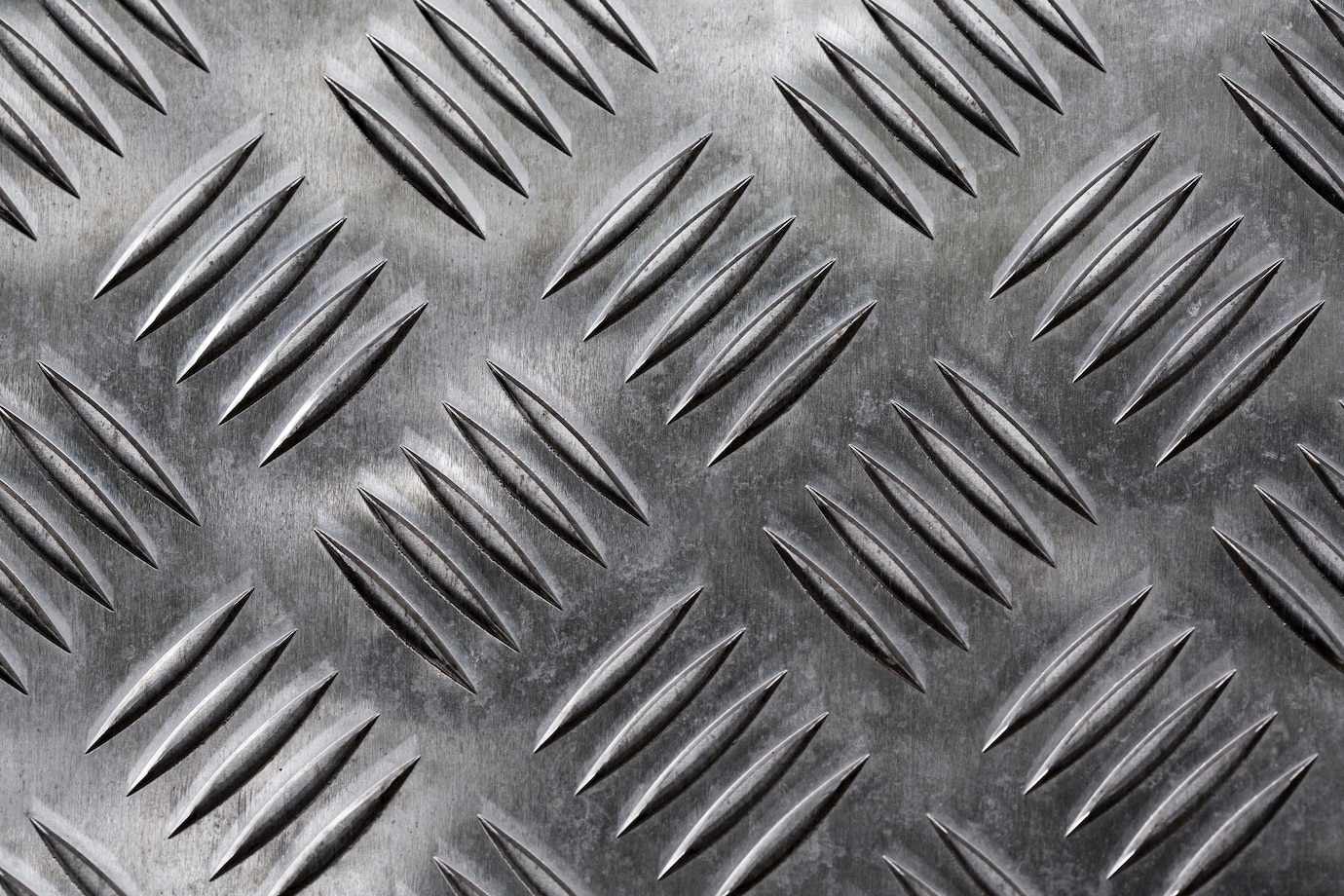
- Corrosion is the gradual destruction of a material, usually metals, by a chemical reaction with the environment. Corrosion degrades the appearance of materials and their strength. Copper has the most detrimental effect on the corrosion resistance of a metal alloy. Magnesium affects the least.
- For the manufacture of heat exchanger plates, we use aluminum alloy 8079, characteristic "0". This alloy is resistant to corrosion processes due to the low content of iron and copper, which quickly oxidize.
- By using the right raw materials, we provide our customers with the very best product, avoiding the hidden problems that may occur after the components are installed.
ADVANTAGES OF A COUNTERFLOW PLATE HEAT EXCHANGER IN COMPARISON WITH OTHER TYPES
THE FOLLOWING ADVANTAGES OF ALUMINUM AS BASE MATERIAL FOR COUNTER-FLOW HEAT PLATE EXCHANGER AGAINST DIFFERENT MATERIALS ARE:
- Aluminum is microbially inert, therefore it is not metabolized and is highly hygienic.
- The airflow is distributed through clearly defined channels, which ensures high performance with low-pressure losses.
- At low ambient temperatures, the aluminum plates of the heat exchanger do not deform.
- At freezing point, the aluminum heat exchanger continues to operate efficiently and leak-free.
- At low temperatures, an aluminum heat exchanger freezes much more slowly than a plastic one.
- Aluminum heat exchangers do not generate electrostatic charges, so there is no dirt accumulation risk.
- Ten sizes are available to cover air volumes from 50 to 3000 m3/h for one unit.
- The precise shape of the construction with absolutely smooth outer surfaces without bolts or screws ensures maximum sealing of the joints and perfect matching to the air conditioning system.
With the ever-increasing cost of electricity and the need to reduce CO2 emissions, the use of air-to-air heat recovery systems is becoming a must. You not only reduce your heating, humidification, and cooling costs, but you also actively participate in reducing your carbon footprint. Your investment will be amortized within a few years of the operation of this system.
























